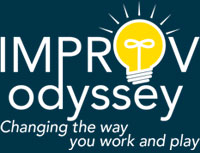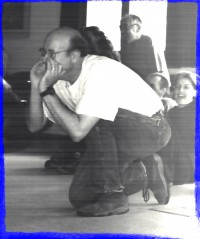The Language of Authority
Do this, don’t do that! Like this! Here’s how I want it! That’s better! That’s rotten! That’s not funny! Now that was FUNNY! That’s what I want! – spoken by a director at a recent improv workshop I attended.
If you teach or direct, you must be mindful of your role as leader and work to be a fellow player rather than the Authority, Know-it-all, etc.
There is great power in words. Choice of words can influence how relationships are determined. The use of some words to represent direction by improv teachers and coaches can be very destructive. Spolin was highly conscious of this vocabulary of authority and strove to counteract the unconscious use of such words often replacing “don’t” (a command from outside) with “avoid” (self-responsibility); “critique” (subjective opinion) with “evaluation” (objective reality).
A side-coach of “Help your fellow player play the game!” encourages mutual trust and attention by each individual to the group as a whole. It also breaks dependency on the teacher by the students and vice versa. These phrases are used consciously, to create a language of peerage and trust rather than a dependency on authority by “those who know.” i.e., teachers and directors or even senior members of a troupe of players. It is a very subtle point, but one of enormous consequence.
For that reason Viola Spolin developed a set of definitions for her work that aid in understanding and delivering direct experiences to players. Some words have the power to confuse and often divert players from the path to true spontaneity and improvisation. For example. “Terrible” “Not Funny” “That’s what I want!” or “That’s more like it.” (spoken as a director/teacher) and even “good, bad, fail,and risk.” These are words that drive the player towards the approval/disapproval syndrome and worry the player they are not doing it right.
As Spolin says: [1All sidecoaching is given during playing. Players do not stop to consider what is being coached, but rather they ACT on it at the moment it is needed. When it works there is a symbiotic connection between coach and players. Sidecoaching excites everyone into action and hurtles everyone into the present.
Glossary of Sidecoaching Phrases (with some additional comments by yours truly.)
Contact! Vowels and consonants! Attitude! Spell! (These words represent different exercises that might be used in a scene not going anywhere to spur connection and/or action and can draw the players back into the scene and keep them out of the head – GS)
Expand that gesture! Pause! Widens experience.
Explore that object! Idea! Sound! Thought! Puts player into a meditative observation as exploration is sought.
Extend that sound! Reinforces movement, sight, thought, character.
Feel that! In your back! Feet! Head! Shoulders! An emotion takes over the whole body.
Give! Take! Take! Give! Awareness of others.
Gibberish! English! No time lag. No “should I or shouldn’t I?” Now! Off-balance is built in. No time to think. (So valuable in keeping true connection with the players -GS)
Heighten that moment … that feeling! Brings a brighter, broader, intensified experience.
Help your fellow player who isn’t playing! Awakens cast to others’ needs. Produces much stage business.
Let your sight flow through your eyes! Let the sound flow through your ears! Let your mind flow through your brain! Useful for SPACE WALKS.
No motion! Stops excessive head control. Puts action and thought on a back burner.
Out of your head, into the space! Be Open for the communication! Useful to get rid of attitudes. Players move out into the stage space. Frees the intuition. (a way of making your fellow player look good) GS
Physicalize that thought! Gives physical (body) expression to a budding, emerging emotion.
See the ceiling! The walls! Look out the window! Awakens the actor to the Where.
See unlabeled! Look unlabeled! Fresh sight is called upon. Creates artistic detachment. (Be careful the student knows what the coach means. If they don’t, they may feel confused (I did at first). Give them what is needed according to your own assessment of each player. – GS)
Share the space between you! Meet in the middle. The between space is where the individual energies can meet. Produces artistic detachment, makes visible to the players what is happening in regard to character and emotion.
Share your voice! Produces projection, responsibility to the audience. Not simply a direction to speak louder, it helps to alert a player organically, without the need for a lecture, to the need for personal interaction with the audience.
Slow Motion! Brings players into the moment of their playing. Details become sharpened. Players see and Feel what is going on.
Stage picture! Helps players to see from the audience’s view. Brings Players and audience into the stage space.
Stage whisper! Reminds players to whisper a audibly intensifies relationships.
Stay out of it! Stops interfering. Stops controls. (Points out the player that they are in their head. – GS)
Two scenes! Two centers; clears confusion
Use your whole body! Helps to physicalize emotions, feelings, thoughts, character. (I always know to call this if they are simply standing around and verbalizing what they should be showing.) Show! Don’t Tell! Is always good too.) GS
You name it! You supply your own sidecoach. (Be careful not to give detailed instructions to be followed, but that each sidecoach phrase spurs them to action and is called without any judgmental asides. i.e., “That was wonderful, Nice job! That sucked!, etc.” because that makes you the authority to be satisfied and robs the player of their own accomplishment. Don’t worry, they’ll know it was good, bad or so-so without you having to tell them.) GS
When you sidecoach, you are making your fellow player look good!
[1 From Theater Games for Rehearsal: A Director’s Handbook, Viola Spolin
Northwestern University Press.


